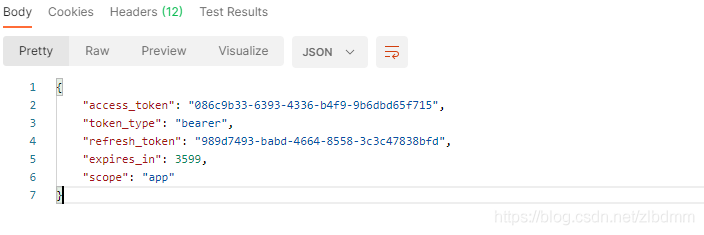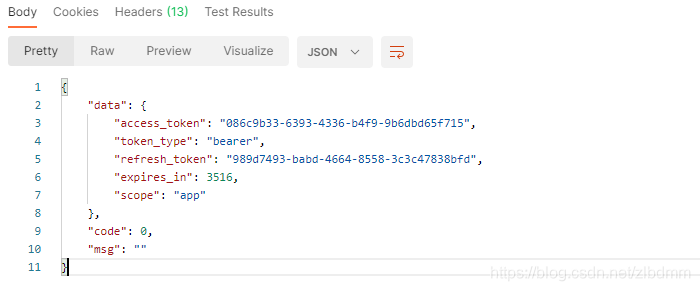Spring Cloud OAuth2中/oauth/token的返回內容格式
背景
在前後端分離的項目中,一般後端返回給前端的格式是一個固定的json格式。在這個前提下,Spring Cloud OAuth2 生成access token的請求/oauth/token的返回內容就需要自定義。
訪問/oauth/token示例如下:

原始返回值的格式如下:

我們希望使用我們自己固定的json格式,如下:

實現原理
原理就是通過切面編程實現對/oauth/token端點請求的結果進行攔截封裝處理,由於/oauth/token是Spring Cloud OAuth2的內部端點,因此需要對相關的Spring源碼進行分析。最終定位到
org.springframework.security.oauth2.provider.endpoint.TokenEndpoint.postAccessToken()
方法上。
代碼實現
相關類
CodeEnum.java
package com.wongoing.common.model;
/**
* @description: 代碼枚舉
* @author: zheng
* @date: Created in 2021/1/26 11:18
* @version: 0.0.1
* @modified By:
*/
public enum CodeEnum {
SUCCESS(0),
ERROR(1);
private Integer code;
CodeEnum(Integer code) {
this.code = code;
}
public Integer getCode() {
return this.code;
}
}
Result.java
package com.wongoing.common.model;
import lombok.AllArgsConstructor;
import lombok.Data;
import lombok.NoArgsConstructor;
import java.io.Serializable;
/**
* @description: Rest API 接口方法返回類型定義
* @author: zheng
* @date: Created in 2021/1/26 13:25
* @version: 0.0.1
* @modified By:
*/
@Data
@NoArgsConstructor
@AllArgsConstructor
public class Result<T> implements Serializable {
private T data;
private Integer code;
private String msg;
public static <T> Result<T> of(T data, Integer code, String msg) {
return new Result<>(data, code, msg);
}
public static <T> Result<T> succeed(String msg) {
return of(null, CodeEnum.SUCCESS.getCode(), msg);
}
public static <T> Result<T> succeed(T model, String msg) {
return of(model, CodeEnum.SUCCESS.getCode(), msg);
}
public static <T> Result<T> succeed(T model) {
return of(model, CodeEnum.SUCCESS.getCode(), "");
}
public static <T> Result<T> failed(String msg) {
return of(null, CodeEnum.ERROR.getCode(), msg);
}
public static <T> Result<T> failed(T model, String msg) {
return of(model, CodeEnum.ERROR.getCode(), msg);
}
}
關鍵切面攔截器
在uaa項目中定義OauthTokenAspect.java
package com.wongoing.oauth2.filter;
import com.wongoing.common.constant.SecurityConstants;
import com.wongoing.common.context.TenantContextHolder;
import com.wongoing.common.model.Result;
import lombok.extern.slf4j.Slf4j;
import org.aspectj.lang.ProceedingJoinPoint;
import org.aspectj.lang.annotation.Around;
import org.aspectj.lang.annotation.Aspect;
import org.springframework.http.HttpStatus;
import org.springframework.http.ResponseEntity;
import org.springframework.security.authentication.InsufficientAuthenticationException;
import org.springframework.security.core.Authentication;
import org.springframework.security.oauth2.common.OAuth2AccessToken;
import org.springframework.security.oauth2.common.util.OAuth2Utils;
import org.springframework.security.oauth2.provider.OAuth2Authentication;
import org.springframework.stereotype.Component;
import java.security.Principal;
import java.util.Map;
/**
* @description: oauth-token攔截器
* 1. 賦值租戶
* 2. 統一返回token格式
*
* @author: zheng
* @date: Created in 2021/7/12 16:25
* @version: 0.0.1
* @modified By:
*/
@Slf4j
@Component
@Aspect
public class OauthTokenAspect {
@Around("execution(* org.springframework.security.oauth2.provider.endpoint.TokenEndpoint.postAccessToken(..))")
public Object handleControllerMethod(ProceedingJoinPoint joinPoint) throws Throwable {
try {
Object[] args = joinPoint.getArgs();
Principal principal = (Principal) args[0];
if (!(principal instanceof Authentication)) {
throw new InsufficientAuthenticationException("There is no client authentication. Try adding an appropriate authentication filter.");
}
String clientId = this.getClientId(principal);
Map<String, String> parameters = (Map<String, String>) args[1];
String grantType = parameters.get(OAuth2Utils.GRANT_TYPE);
//保存租戶id
TenantContextHolder.setTenant(clientId);
Object proceed = joinPoint.proceed();
if (SecurityConstants.AUTHORIZATION_CODE.equals(grantType)) {
/**
* 如果使用 @EnableOAuth2Sso 註解不能修改返回格式,否則授權碼模式可以統一改
* 因為本項目的 sso-demo/ss-sso 裡面使用瞭 @EnableOAuth2Sso 註解,所以這裡就不修改授權碼模式的token返回值瞭
*/
return proceed;
} else {
ResponseEntity<OAuth2AccessToken> responseEntity = (ResponseEntity<OAuth2AccessToken>) proceed;
OAuth2AccessToken body = responseEntity.getBody();
return ResponseEntity
.status(HttpStatus.OK)
.body(Result.succeed(body));
}
} finally {
TenantContextHolder.clear();
}
}
private String getClientId(Principal principal) {
Authentication client = (Authentication) principal;
if (!client.isAuthenticated()) {
throw new InsufficientAuthenticationException("The client is not authenticated.");
}
String clientId = client.getName();
if (client instanceof OAuth2Authentication) {
clientId = ((OAuth2Authentication) client).getOAuth2Request().getClientId();
}
return clientId;
}
}
其中的常量值:
public abstract class OAuth2Utils {
public static final String GRANT_TYPE = "grant_type";
}
public interface SecurityConstants {
/**
* 授權碼模式
*/
String AUTHORIZATION_CODE = "authorization_code";
}
到此這篇關於Spring Cloud OAuth2中/oauth/token的返回內容格式的文章就介紹到這瞭,更多相關Spring Cloud OAuth2返回內容格式內容請搜索WalkonNet以前的文章或繼續瀏覽下面的相關文章希望大傢以後多多支持WalkonNet!
推薦閱讀:
- Spring Cloud OAuth2實現自定義token返回格式
- Springboot開發OAuth2認證授權與資源服務器操作
- Spring Security OAuth 自定義授權方式實現手機驗證碼
- 如何設計一個安全的API接口詳解
- 使用SpringSecurity 進行自定義Token校驗